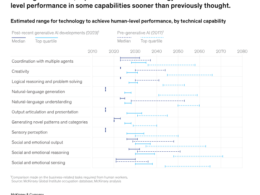the health strategist
knowledge platform
for health management, engineering
and technology
Joaquim Cardoso MSc.
Chief Research and Strategy Officer (CRSO);
Chief Editor and Senior Advisor
August 2, 2023
What is the message?
The strategic adoption of generative AI requires careful consideration of its potential for creating value, capturing that value through the business model, uniqueness in deployment, and continuous adaptation to stay ahead of the competition.
It is not a one-size-fits-all solution, and each company must assess its specific case to determine if generative AI can indeed be a strategic advantage.
What are the key takeaways?
The strategic adoption of generative AI requires thoughtful consideration and evaluation of its potential for creating competitive advantage.
Companies should not simply adopt the technology based on hype or fear of missing out, but instead, they need to carefully assess its specific applications and its ability to create significant new value.
Additionally, companies must have a clear plan for capturing the value generated by generative AI in their business models.
Not all adopters of generative AI will gain a competitive advantage, and success depends on how well companies can address four key questions related to value creation, value capture, uniqueness, and continuous adaptation.
The 4 questions to determine whether generative AI can justify a claim of competitive advantage in their particular case, are:
- Question #1: Can you create significant new value with generative AI with your specific application?
- Question #2: Are you able to capture value generated by generative AI?
- Question #3: Are you able to deploy generative AI in a unique way, not easily replicated by others?
- Question #4: How will generative AI enable your next move, if competitors were to catch up?
What this means for strategists?
Strategists should approach generative AI with measured enthusiasm.
- They should thoroughly analyze its potential for value creation and ensure a strong value capture mechanism.
- The focus should be on leveraging the technology in a unique way, continuously adapting to changing circumstances, and avoiding blind adoption without clear strategic alignment.
By thoughtfully addressing these factors, strategists can increase the likelihood of generative AI contributing to a sustainable competitive advantage in their organizations.
DEEP DIVE

Measured Enthusiasm
Is generative AI as “strategic” as it is claimed to be?
BCG Henderson Institute
MARTIN REEVES
CHRISTIAN STADLER
August 2, 2023
“I heard you could watch a live baseball game on the internet… does radio ring a bell?” quipped comedian David Letterman in 1995. Nevertheless, in 1999, Yahoo paid $5.7Bn for the start-up broadcast.com, an internet radio streaming service — only to shut it down in 2002. Yet, in spite of being labeled one of the worst technology acquisitions ever, it arguably paved the way for several subsequently successful streaming services like Spotify.
When a new technology like generative AI is hot, no one wants to be left behind. Yet the broadcast.com story well illustrates that neither initial skepticism nor subsequent excitement is any guarantee of failure or success respectively and that first movers are not always the eventual winners.
AI has actually been here before. During the 1980s AI boom, investors chased start-ups that pitched exciting new technologies, seemingly neglecting to ask which problems they actually solved and what value and competitive advantage they created. Not surprisingly, first-generation AI companies like Symbolics, Intellicorp, and Gensym either transformed or disappeared. So is generative AI as “strategic” as it is claimed to be?
The key is to think about the potential for competitive advantage in specific applications. A new technology can be novel, it can be useful, it can even generate massive value for consumers and providers, but without creating sustainable competitive advantage in specific applications, it can easily distract and divert attention and resources from more promising opportunities.
To avoid these pitfalls, firms should ask 4 questions to determine whether generative AI can justify a claim of competitive advantage in their particular case.

Question #1: Can you create significant new value with generative AI with your specific application?
Advantage cannot merely be claimed for a technology overall without probing the specific application. Like broadcast.com and streaming technology, many applications of ultimately successful technologies will likely fail to create value. In another example, digital platform technologies underpin some of the most successful businesses on the planet, but our research shows that only 15% of would be digital ecosystems have proven successful. Without an explicit thesis on how value will be created, success is extremely unlikely.
Probe whether and how customers’ existing “jobs to be done” will be executed more efficiently with fewer required resources, completed to a higher level of quality on a valued dimension, or whether new valuable jobs will become possible.
All new technology applications carry risk and the potential rewards need not merely to exist but to be proportionate to the risk. Ask therefore whether the magnitude of the value created justifies risk and whether it could be achieved more easily by incrementally improving the existing model.

Question #2: Are you able to capture value generated by generative AI?
With new technologies often a claim is made that it would be disadvantageous not to do something that everyone else is doing. However, the absence of disadvantage does not necessarily equate to the creation of advantage.
There has to be a link between value creation and capture in the proposed business model. When every company built a website in the late 1990s it was easy to see that not building one would be disadvantageous. But a website did not automatically translate into value generation. Neither will a dip into AI suffice.
Consider how careful Google has been in deploying large language models. Advertising is currently the main revenue generator for Google. For now it is not clear how Google could capture any value generative AI created for users as effectively as advertising does for its existing model.
Additionally, users expect reliable data and referencing when using its search engine. Generative AI might be able to support this in future but it cannot do so currently. The conundrum is to know when a new technology solves a customer’s problem better than other alternatives to justify switching over.
Value capture requires explicit thought especially in digital businesses, which often rely on an ecosystem of collaborators, since orchestrating firms must monetize without competing with and alienating other ecosystem participants. This explains why monetization is often indirect in digital businesses, frequently via advertising.

Question #3: Are you able to deploy generative AI in a unique way, not easily replicated by others?
A technology may create greater operational efficiency but if it is freely available to all on similar terms then it can quite easily be competitively neutral. Unique advantage usually pertains to something which is very hard for others to replicate. This can be something physical like scale (e.g. Coca-Cola’s distribution network) or experience (e.g. Hermės unique craftsmanship), a capability which is hard to build or acquire (e.g. Netflix’s global network of creative talent) or something which is intrinsically complex, like the creation and operation of an integrated system of multiple activities (e.g. Grab’s super-app).
More than the underlying technology, OpenAI’s initial advantage to date has been its intuitive interface. But there are many competing technologies in play and this initial advantage will need to be reinforced, for example by creating unassailable user or data scale through its partnership with Microsoft. More importantly, the question of OpenAI’s advantage should not be confused with the entirely different question of how the specific applications of LLMs can be designed in a way which make it hard for others to copy.

Question #4: How will generative AI enable your next move, if competitors were to catch up?
Classically, when strategists talked about sustainable competitive advantage, they were referring to economics of scale or experience which were not easy for competitors to match or overtake. In today’s fast-moving, hyper-competitive settings that’s much harder to achieve. A more feasible option nowadays is to create renewable or serial temporary advantage, such as an ability to learn from proprietary data to continuously evolve the business model e.g. the way Meta or Amazon have been able to lock in customers by knowing them well enough to continuously offer customized and new services, including through new business models.
This last question is an acknowledgement that it is unlikely that you are able to prevent copy-cats in the digital world. That’s not an insurmountable problem though. Apple, Amazon, Alphabet, Meta, Microsoft, Alibaba, and Tencent have all evolved substantially over time. At critical points these companies were able to embrace new growth-engines built on the foundation of earlier trajectories. Microsoft CEO Satya Nadella, for example, embraced the service model, moving beyond Windows as a product.

What this means for strategists?
How great is the danger of illusory advantage specifically with generative AI?
The unprecedented rollout spread of generative AI fuels the perception that the technology will change everything and it could therefore be gravely disadvantageous not to engage rapidly. But an argument which is primarily built on FOMO will fall prey to our second criterion. Open source or publicly available LLMs are freely available to all, so the mere use of the technology, even in an operationally effective manner, can easily create merit for consumers which is competitively neutral or might even increase the costs of doing business.
Finally, with a new technology like generative AI, it’s easy to equate the opening game with the end game. Most technology revolutions have required accompanying applied innovations to unlock their full potential. Electricity in itself did not immediately translate into big productivity gains for industry. This only happened as new technologies like electric motors and social innovations like new factory layouts took hold. With generative AI too, attention should therefore be focused on specific applications, and complementary technology and business model innovations.
All of this is not to say that generative AI cannot create competitive advantage, but that this needs to be thought about very deliberately. By definition, competitive advantage cannot be created for all adopters of a new technology. There is almost certainly potential advantage in leveraging proprietary data, sourced from a digital ecosystem whose scale and customer integration is hard to replicate, for example. But whether your specific application will flourish rests on your answers to our four questions.
Originally published at https://bcghendersoninstitute.com on August 2, 2023.












